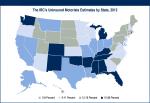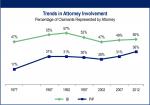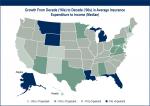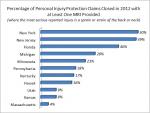Research Publications
Trends in Homeowners Insurance Claims, 2015 Edition
This report documents homeowners insurance claim frequency, severity, and loss cost trends from 1997 to 2013. Special emphasis is given to the role of catastrophe-related claims. Countrywide and state findings are presented.
Fraud and Buildup and Auto Injury Insurance Claims
This report provides a unique perspective on claim abuse among auto injury claims closed with payment. Using data from the 2012 closed claim data collection, it describes the prevalence of fraud and buildup among the five main private passenger coverages and includes analysis of different types of abuse, estimates of the excess payments attributable to fraud and buildup, variations by state. It also examines the differences in claiming behavior between claims with the appearance of abuse and other claims and provides information about some of the fraud-fighting tools used by insurers.
Third-Party Bad Faith in Florida’s Automobile Insurance System
Bad-faith lawsuits targeting automobile insurers in Florida impose a heavy burden on the state’s auto insurance system and auto insurance consumers. This report examines the effect that potential bad-faith settlements have on underlying claiming behavior in Florida. Estimates of additional claim costs attributable to the bad-faith legal environment are included.
Uninsured Motorists, 2014 Edition
This study examines trends in the percentage of uninsured motorists by state utilizing uninsured motorists and bodily injury claim frequencies from 2010-2012. The report also produces quantitative estimates by state and over time for the amount of uninsured motorists and total uninsured motorist claim payments.
Attorney Involvement in Auto Injury Claims
This report uses data from the 2012 closed claim study to examine trends in the rate of attorney involvement in auto injury claims over time and across states. It also provides details on the interaction between the presence of attorneys and cost drivers such as medical treatment and claim abuse and looks at how represented claimants fare compared to claimants without attorneys with respect to claim payment and time to settlement.
Auto Injury Insurance Claims: Countrywide Patterns in Treatment, Cost and Compensation, 2014 Edition
This publication shows dramatic increases in claimed medical expenses and examines some of the factors driving them. The closed claim study, the seventh of its kind conducted by the IRC, is based on a sample of more than 35,000 auto injury claims paid in 2012. The study examines trends in claim patterns, including details on injuries, medical treatment, claimed losses and payments, attorney involvement, and fraud.
Auto Insurance Affordability
This report presents a new methodology for studying automobile insurance affordability and examines changes and differences in affordability over time and across states. The study also inspects the drivers of automobile insurance affordability.
Expert Views of Auto Insurance Rate Regulation
This report surveys academic experts in risk and insurance on the effectiveness of prior approval and market-oriented rate regulatory policies in automobile insurance. The results show that a vast majority believe the prior-approval regulation of auto insurance rates is unnecessary and does not benefit consumers.
Interstate Differences in Medical Utilization in Auto Injury Claims
Based on a detailed review of more than 30,000 auto injury claims closed with payment in 2012, this report documents substantial differences across states in the utilization of key medical diagnostic and treatment services. The study examined utilization patterns for MRIs and CT scans, as well as for treatment provided by chiropractors and physical therapists. Documenting extreme variation in utilization patterns for similar types of claims suggests opportunities for improving the quality of care provided to auto injury claimants and reducing the cost of auto injury claims.
Insurance Fraud: A Public View, 2013 Edition
This report updates previous IRC studies surveying the public about the acceptability and perceived frequency of various types of insurance fraud, with special emphasis on auto insurance fraud. It also examines attitudes toward a variety of tools that insurers and law enforcement use to fight against insurance fraud, including claim handling techniques and consequences for fraudulent behavior, and the public’s willingness to perform fraud-fighting efforts. The study finds lower tolerance of fraud than in past studies and broad support for measures designed to reduce fraud.









